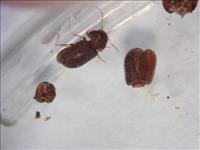
Caption: Adult drugstore beetle, size- 1/8 inch
Photo by: M. Bush
|
|
Drugstore beetle
(revision date: 7/14/2015)
Use Integrated Pest Management (IPM) for successful pest management.
Biology
Adult drugstore beetles are reddish-brown beetles about 1/8 inch long. Their head is bent downward, making it difficult to see their head when viewed from above. How long a drugstore beetle lives depends on its food source and environmental conditions. The larvae are C-shaped creamy white grubs and can feed for two to twenty months. Drugstore beetles are not picky eaters and have been documented eating just about everything. They commonly feed on dried, stored products such as flour, dry mixes, chocolate, spices, dried herbs, cookies, stored grains, dried fruits and vegetables, and dried pet foods. They will also eat wool, leather, horns, hides, books and wood. And more amazingly, drugstore beetles will feed on drugs and toxins, such as strychnine powder. How do drugstore beetles survive on such a varied diet? There is a symbiotic organism resembling yeast living in their gut that helps them digest their food. This yeast also produces complex nutrients for the beetle, which make it possible for it to eat so many low-quality food items.
|
|
Management Options
Non-Chemical Management
- Closely inspect food items in pantry and throw out heavily infested foodstuffs.
- Don't store excess foodstuffs, such as grains, cereals, baking mixes, nuts, etc. unprotected or for long periods of time.
- Keep dry pet foods away from the general pantry area and in a tightly-sealed container.
- Store food items in tightly-sealed containers.
- Vacuum and clean food debris from cracks and corners of storage areas.
- Sanitation or location and elimination of the source of infestation are the only long-term controls.
Select non-chemical management options as your first choice!
Chemical Management
None recommended.
|
